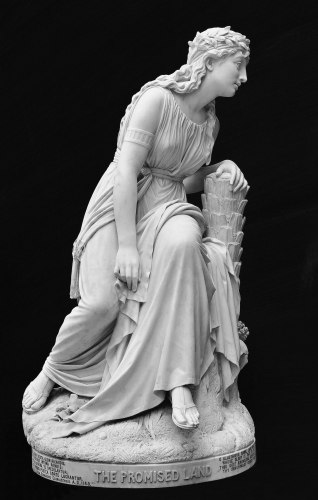Franklin W. Simmons

The Promised Land, 1873–74
Franklin W. Simmons (1839 – 1913)
Franklin Simmons, known for commemorative portrait busts and life-size figural pieces, was born in Lisbon, Maine, and died in Rome, Italy. He was raised in Bath, Maine, where he started sculpting while working in a cotton mill in Lewiston. He studied briefly with John Bradley Hudson, Jr., an itinerant landscape painter, who seeing that Simmons was not particularly interested in painting, suggested he turn exclusively to sculpture.
Taking Hudson’s suggestion Simmons went to Boston for further training, which he obtained from John Adams Jackson, who was a Maine native and who guided Simmons in becoming skillful with plaster molds and casts.
By 1857, Hudson had opened a studio in Lewiston and from there traveled throughout the state for portrait-bust clientele. After modeling a number of busts and cameos, he moved to Portland, Maine from where he filled over one-hundred commissions, achieving his goal of doing more public than private portraiture.
During the Civil War, Simmons moved to Washington DC and made busts of many leading persons there, including a marble bust of William Tecumseh Sherman, which is now in the collection of the Fine Arts Museum of San Francisco. In 1864, Simmons began a commission to execute a series of twenty-four bronze relief portraits of Civil War heroes, and completed in 1866, these works became known as the National Bronze Picture Gallery.
The town of Rockland, Maine commissioned him to do statues of Major General Hiram Berry, who had died at the Battle of Chancellorsville. Upon completion, this work was the first life-size portrait statue in Maine and was a considerable boost to the reputation of Simmons.
Officials of the state of Rhode Island, as recommended by Ulysses S. Grant, hired Simmons to do a life-size statue of the state’s founder, Roger Williams, which was completed in 1872 for the Statuary Hall of the U.S. Capitol building.
Meanwhile, Simmons had become especially interested in neoclassical marble statuary with Biblical and literary themes. By the early 1870s, he had joined his friend William Wetmore Story in Rome and spent the remainder of his life there with occasional returns to the United Sates. In Italy, he was knighted by King Humber, receiving the Cross of Caxilere, and was the first American artist to earn this honor.
With no heirs, he left his estate to the city of Portland, Maine, and his estate collection is now located at the Portland Museum of Art near his public sculptures, the Longfellow Monument (1888) and The Republic (1891)
Sources:
Laureta Dimmick, “Franklin Simmons”, American Sculpture in The Metropolitan Museum of Art, Volume One, Thayer Tolles, Editor
Peter Hastings Falk, Editor, Who Was Who in American Art, Vol. III
Biography from the Archives of AskART